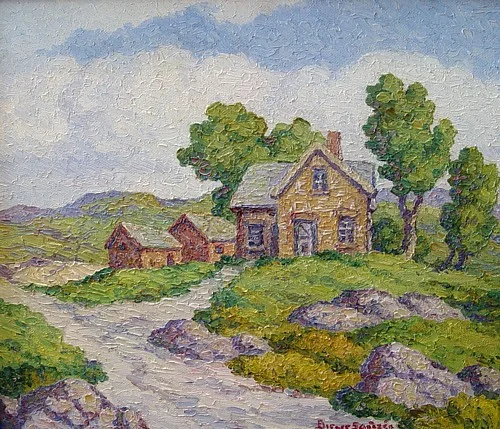Are you interested in selling or consigning your artwork?
Contact us now for a free opinion of value
Birger Sandzen
Birger Sandzén (1871–1954) was a Swedish-American artist born in Blidsberg, Sweden, and spent the majority of his successful career in Lindsborg, Kansas. In Sweden, he studied at the College and Academy of Skara, and at Lund University, one of the oldest universities in Northern Europe, where he took classes in French and Art History. He later attended the technical high school in Stockholm, where he was taught to draw figures and learned the principles of perspective. He studied in Paris before emigrating to Lindsborg in 1894 to teach fine art, art history and French at Bethany College where he remained on the faculty until 1946. He made trips to Santa Fe and Taos, New Mexico beginning in 1918 and, in 1922, exhibited with the Taos Society of Artists in New York.
A man of many diverse talents and interests, Sandzén was very influential in the art community in Kansas, making arrangements for exhibitions and organizing art clubs. He painted murals for several branches of the U.S. Postal service and also worked as a book illustrator. His personal art collection included hundreds of paintings and drawings of the American west. He was also a talented etcher, engraver, and lithographer, producing many editions of scenes from Kansas and Colorado.
Sandzén is best known for his vibrant color palettes, bold brushwork, and expressionist landscapes inspired by the American West. He featured colorful, dynamic landscapes depicting mountain lakes and rivers, boulders, aspen trees and rustic buildings. One of the artist's favorite locations was the Smoky Hill River area of central Kansas. In 1916 he visited Colorado, where he was inspired by the natural beauty of the land in the area, particularly the breathtaking settings offered by the Rocky Mountain National Park, Estes Park and the Dillon Pinnacles, a group of towering volcanic formations that dominate the Curecanti National Recreation Area's landscape. He also taught some classes at the Broadmoor Hotel, Denver College, and Utah State College.
The style and spirit of his works evolved from Pointillism and Fauvism to a mature Post-Impressionist and Expressionist approach. Sandzen's thick impasto technique, though uniquely individual, is reminiscent of Van Gogh and Cézanne. His prime period (1920s–1930s) featured canvases ignited by luminous hues and energetic texture. Later, he favored a softer, more subdued palette, with paint application still vigorous yet slightly restrained. Sandzen’s hues remained brighter and bolder than most contemporaries’, and his surfaces stayed thickly layered with robust brushstrokes. These later works retained their vivid, expressive quality, each stroke undulating with movement, reflecting his irrepressible enthusiasm.
Sandzén’s work is internationally renowned, held in collections like the Metropolitan Museum of Art, the Uffizi, the British Museum, the Denver Art Museum, and the Library of Congress. Growing collector demand for his prints and oil paintings has seen works auctioned at Heritage Auctions and Sotheby’s, a testament to his enduring appeal.
For additional information, visit:


























